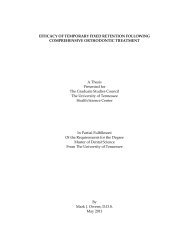BEVACIZUMAB EFFECT ON TOPOTECAN PHARMACOKINETICS ...
BEVACIZUMAB EFFECT ON TOPOTECAN PHARMACOKINETICS ...
BEVACIZUMAB EFFECT ON TOPOTECAN PHARMACOKINETICS ...
You also want an ePaper? Increase the reach of your titles
YUMPU automatically turns print PDFs into web optimized ePapers that Google loves.
drug penetration. Pre-treatment with 1 μM non-radiolabeled paclitaxel enhanced the<br />
penetration rate of [ 3 H] paclitaxel in a human pharynx FaDu xenograft [53].<br />
The second strategy that researchers have used is a targeting delivery system or<br />
improved drug property to increase the drug distribution in solid tumors. The targeting<br />
delivery system mainly uses two principles: passive targeting or active targeting [54].<br />
Passive targeting involves enhancing the drug carrier permeability and retention in solid<br />
tumors by designing the particle size too large to diffuse through normal blood vessels<br />
but small enough to exit the abnormally large pores on the tumor vessel walls to<br />
extra-vascular space. With more drugs in the extra-vascular space by the passive<br />
targeting system, relatively more drug will diffuse into solid tumors and restrict it in the<br />
tumor tissue due to lack of a functional lymphatic system [55]. The active targeting<br />
strategy employs the specific tumor microenvironment by attaching ligands to the carrier<br />
surface that can bind to tumor specific receptors and antigens through molecular<br />
recognition. These receptors and antigens include the cancer cell surface antibodies [56],<br />
folate receptor [57], transferrin receptors [58] and angiogenic vascular surface proteins<br />
[59]. Another modification for deeper drug penetration is to use live bacterial vectors<br />
such as Salmonella sp, Clostridium sp and Escherichia coli based on their<br />
tumor-colonizing characteristics [60]<br />
In summary, numerous strategies have been developed to increase cytotoxic drug<br />
penetration in solid tumors. The normalization of tumor vasculature is one of the most<br />
popular methods to enhance drug penetration.<br />
1.2 Angiogenesis and Anti-angiogenic Therapy<br />
1.2.1 Angiogenesis in solid tumors<br />
Angiogenesis is the physiological process of new capillaries generation from<br />
pre-existing blood vessels [7]. In normal tissue, angiogenesis is precisely regulated by<br />
keeping a balance between pro-angiogenic factors, such as VEGF and PDGF, and<br />
anti-angiogenic factors, such as thrombospondin-1 and angiostatin [61]. Regulated<br />
angiogenesis provides organs and tissue sufficient nutrition and oxygen to grow and<br />
recover from wound healing [62]. Under pathological conditions, the balance of<br />
pro-angiogenic factors and anti-angiogenic factors is broken and leads to dysfunctional<br />
and structurally abnormal vasculature. Unregulated angiogenesis plays a critical role in<br />
solid tumor growth and metastasis [63]. As in normal tissue, a tumor beyond 0.5mm in<br />
diameter relies on angiogenesis to supply nutrition and oxygen for survival and growth<br />
[64]. Furthermore, the dilated and leaking intra-tumoral blood vessels allow the tumor<br />
cells to enter the blood circulation and metastasize to distant organs [65]. In this context,<br />
the anti-angiogenesis approach as a tumor treatment strategy has been investigated<br />
extensively.<br />
5
















